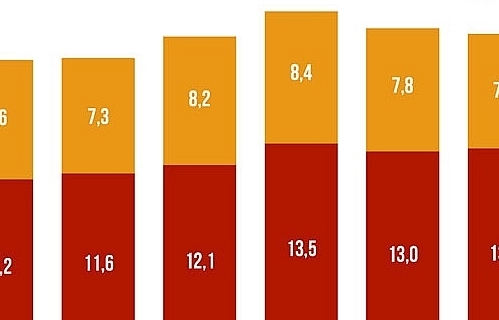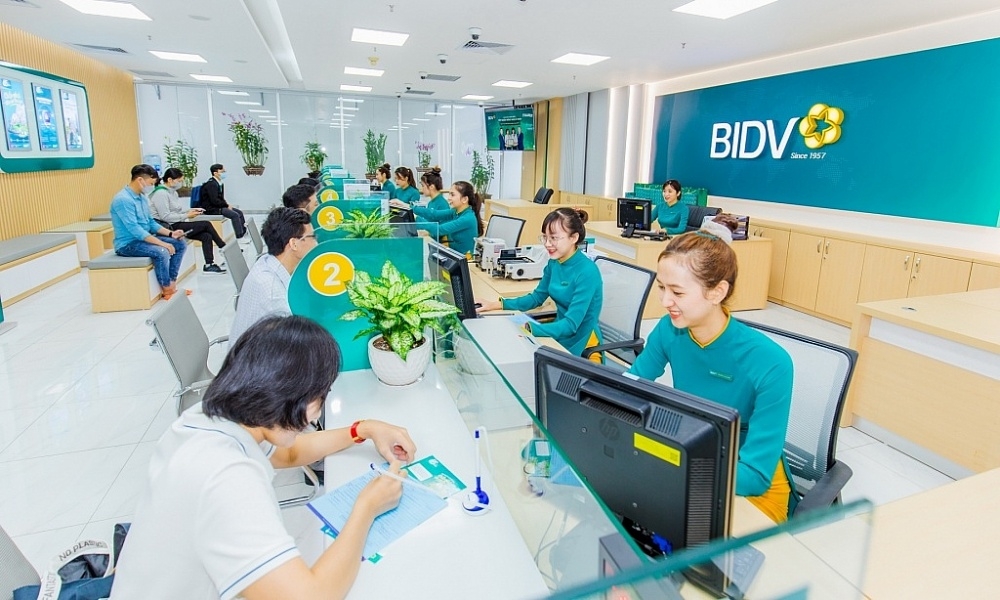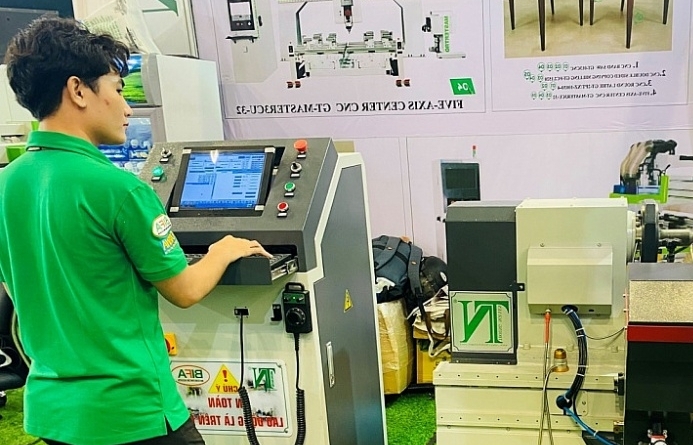Invest early to catch opportunities from the carbon credit market
| Cases of production and trading of fake goods prosecuted | |
| Rice exports need a long-distance calculation | |
| VIFTA- Opportunity for Vietnamese seafood to enter the Middle East market |
 |
| Duy Tan Plastic Recycling Factory turns used plastic bottles into safe bottles that can be used for food. Photo: T.L |
Many benefits
Vietnam has participated and actively prepared for the formation and development of the domestic carbon market, towards integration with the region and the world. On January 7, 2022, the Government issued Decree 06/2022/ND-CP regulating the mitigation of greenhouse gas emissions and the protection of the ozone layer. Accordingly, from now until the end of 2027, Vietnam will build regulatory systems and policies to create a foundation for the market to operate as well as establish and organize a pilot operation of a carbon credit exchange. Vietnam aims to officially operate a carbon credit exchange from 2028.
One of the key elements in designing the domestic carbon market is the allocation of quotas. According to Clause 2, Article 2 of Decree 06/ND-CP, the quota allocation method to be applied to the domestic carbon market will be based on the GHG emission norm per unit of product (OBA).
According to this regulation, Mr. Trinh Nam Phong, specialist in carbon credit projects and policy consultant, VNEEC Energy and Environment Consulting Joint Stock Company, said that large greenhouse gas emission facilities would be the subjects which were most affected when participating in this market. Enterprises can be directly affected to their production capacity when they are imposed an emission limit, the amount of products that enterprises produce will be limited, or are under pressure to switch technology as well as the competitiveness will be directly affected.
In addition to concerns about the risk of being affected when the carbon credit market comes into operation, Mr. Trinh Nam Phong also pointed out that if enterprises implement emission reduction measures to reduce the actual emission intensity to be below the standard emission intensity, there is the possibility of generating excess emissions quotas, thereby generating revenue by trading excess quotas or using excess quotas to increase production. The advantage of the OBA allocation method is that it does not limit enterprises in developing and expanding production and business, but only limits the emission intensity per product unit, so it is suitable for application in developing countries.
In addition to the ability to generate additional revenue from the trading of quotas or carbon credits, participating in the carbon market also helps enterprises to improve their image and increase their competitiveness when participating in markets where carbon pricing mechanism is applied, thereby, contributing to national and global GHG emission reduction targets.
The sooner the investment is, the lower the cost is
In fact, many businesses have soon identified opportunities and challenges from the carbon credit market to make appropriate preparations. In particular, many businesses in the agricultural sector have seen great potential from generating carbon credits from their own growing areas. In which, Loc Troi Group is developing a low-carbon rice production project with the aim of making more profit from selling carbon credits; Tra Vinh Farm Co., Ltd is also making active preparations to be able to generate carbon credits from the company's coconut plantations.
Even industrial enterprises are transforming to be able to "turn risks into oppotunities" when the carbon credit market comes into operation. As at Duy Tan Plastic Recycling Company, Mr. Le Anh, Director of Sustainable Development, said that if there was no sustainable development roadmap, in the future businesses would have to spend a lot of money to buy carbon credits. Therefore, Duy Tan Plastic Recycling Company is investing so that it can soon operate a carbon-reducing factory with the 3 zero criteria: no waste water, no emissions, no waste. This enterprise is collecting used plastic bottles to recycle into safe bottles to supply food and drink processing businesses under a global brand.
Mr. Le Anh also acknowledged that, for enterprises with long-standing production lines, old technology will face a big challenge in terms of costs. However, the fact that green economy and sustainable development is a global trend, including importing countries, many businesses have made strong commitments to accompany the goal of sustainable development. “Investing in green credits and sustainable development is not necessarily an expense, but it will bring competitive advantages to businesses, helping them to develop and reach the global level. The sooner the investment is, the lower the cost is and the greater the benefit will be," emphasized Mr. Le Anh.
Vietnam Dairy Products Joint Stock Company is also one of the businesses that are making strong strides in Vietnam's journey towards the goal of Net Zero by 2050. Vinamilk Nghe An Dairy Factory and Vinamilk Nghe An Dairy Farm are the first two units to achieve carbon neutrality according to PAS2060:2014 standards with more than 17,560 tons of CO2 absorbed. This result comes from the "dual action" of reducing emissions in production and animal husbandry while maintaining a fund of trees to absorb greenhouse gases for many years. This enterprise is also implementing the project "Net Zero Vinamilk Forest" to help shape green areas, absorb CO2 and inspire in the community about protecting nature, encouraging the planting of trees.
Regarding the PAN Group, Ms. Nguyen Thi Tra My, General Director of PAN Group, said that international customers, especially from high-end markets such as the EU, are demanding a "carbon footprint" or climate footprint on each seafood product. Customers are increasingly aware of the importance of “carbon footprint” disclosure, through a number of specific requirements such as fishing control regulations, requirements for fishing certification or re-export of imported seafood products and encourage “carbon footprint” notices on products.
Therefore, reducing greenhouse gas emissions is one of the key tasks that have been included in the sustainable development strategy of PAN Group. Currently, this enterprise is building a roadmap to inventory and reduce emissions at each member company. Accordingly, each unit will have its own roadmap in accordance with the characteristics of production, business and applicable conditions at their units.
Related News

Agricultural, forestry and fishery exports “reach the target” early
15:20 | 19/12/2024 Import-Export

The way for Vietnamese goods in the e-commerce race
11:08 | 30/11/2024 Import-Export

Sustainable production will bring advantages to Vietnamese pepper and spices
13:44 | 06/12/2024 Import-Export
Latest News

Top 10 Reputable Animal Feed Companies in 2024: Efforts to survive the challenges of nature
18:30 | 21/12/2024 Import-Export

Vietnam's import-export surges 15.3%
09:44 | 20/12/2024 Import-Export

More Vietnamese firms interested in Saudi Arabia: Ambassador
09:43 | 20/12/2024 Import-Export

“Give and Take” in the Value Chain of the CPTPP Market
09:30 | 20/12/2024 Import-Export
More News

Binh Dinh province works to attract investment from Japan
15:44 | 19/12/2024 Import-Export

Thailand remains Vietnam’s biggest trading partner in ASEAN
15:35 | 18/12/2024 Import-Export

Rubber value soars in 2024: VRA
15:33 | 18/12/2024 Import-Export

Vietnamese businesses struggle to access green finance
09:58 | 18/12/2024 Import-Export

E-commerce: a gateway to boost Vietnamese commodities in the UK market
16:55 | 17/12/2024 Import-Export

Agro-forestry-fisheries exports top 62 billion USD in 2024
16:51 | 17/12/2024 Import-Export

Removing “bottlenecks” for digital transformation in industrial production
10:00 | 17/12/2024 Import-Export

UKVFTA facilitates Việt Nam's tuna exports to UK market
13:56 | 16/12/2024 Import-Export

Vietnam’s garment-textile exports expected to reach 44 billion USD this year
13:53 | 16/12/2024 Import-Export
Your care

Top 10 Reputable Animal Feed Companies in 2024: Efforts to survive the challenges of nature
18:30 | 21/12/2024 Import-Export

Vietnam's import-export surges 15.3%
09:44 | 20/12/2024 Import-Export

More Vietnamese firms interested in Saudi Arabia: Ambassador
09:43 | 20/12/2024 Import-Export

“Give and Take” in the Value Chain of the CPTPP Market
09:30 | 20/12/2024 Import-Export

Binh Dinh province works to attract investment from Japan
15:44 | 19/12/2024 Import-Export




